According to a study, 89% of college presidents have admitted that plagiarizing information has become easier courtesy of computers and the internet (LENHART, 2011). This ratio shows that it is becoming challenging for students to create plagiarism-free assignments in this digital age. That is why we have created a plagiarism prevention guide for students affected by plagiarism.
Here, we’ll discuss some effective plagiarism prevention techniques and resources. But first, we’ll discuss the concept of plagiarism because one of the prerequisites for avoiding plagiarism is to understand what plagiarism exactly is. So, without any further delay, let’s begin.
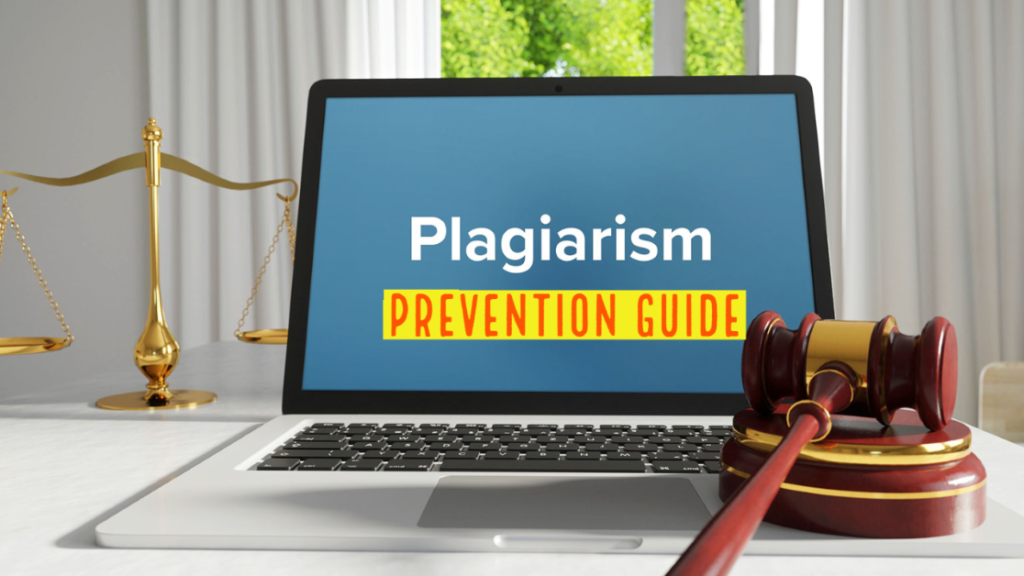
A Brief Introduction to the Concept of Plagiarism
Plagiarism occurs when an individual uses another person’s work, concepts, or language as if it were their own without proper acknowledgment of the initial source. It is a form of intellectual robbery because the person who plagiarizes takes another individual’s dedicated efforts and attempts to represent it as their own.
Plagiarism can have serious repercussions, especially on the life of students. For instance, students can fail a course, lose the opportunity to have a scholarship, or even get expelled from the institute.
Four Plagiarism Prevention Strategies
Now that you’ve understood the concept of plagiarism, it’s time to discuss the strategies for how to prevent plagiarism in research and other educational fields. That’s because after grasping the concept of plagiarism, understanding these techniques will be easier for you.
- Do Proper Research
When it comes to preventing plagiarism, one of the most straightforward and effective tips is creating original content. But creating original content is dependent on conducting proper research. Therefore, the first plagiarism prevention strategy is to conduct extensive research on your topic. That way, you’ll be less likely to involuntarily copy a source and use the same words as them.
The results of the research phase are directly proportional to time availability. So, the more time you’ll have, the better research you’ll be able to conduct on your topic. That is why we recommend starting working on your topic early.
When you start working early, you won’t have the pressure of running out of time, which means you can carry out the research phase with proper planning. So, research your topic on the following reputable sources:
- Academic journals.

- Books.

- Google Scholar.

- High authoritative websites.
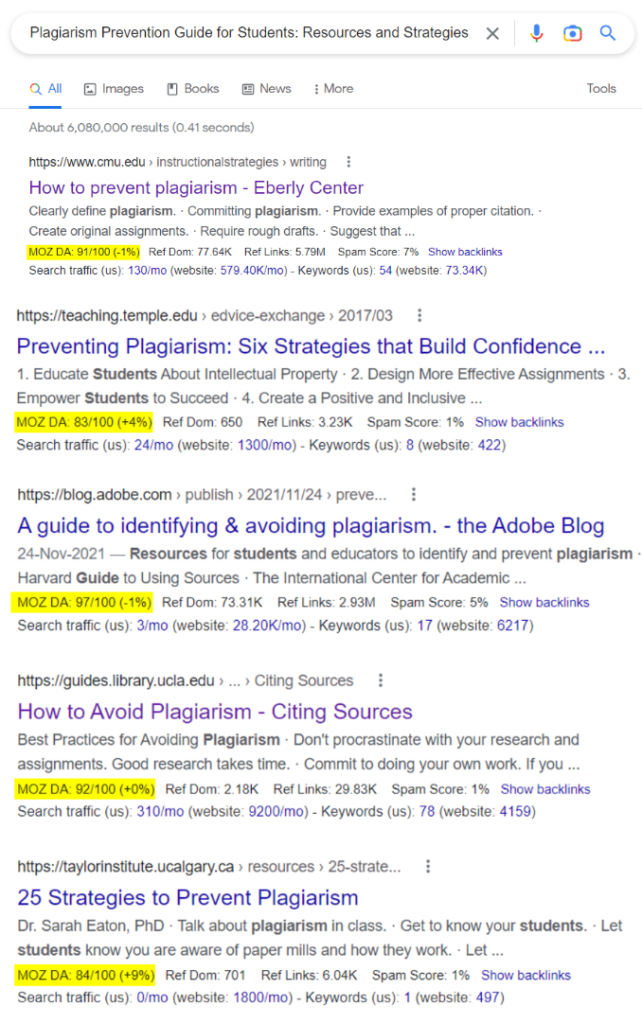
The authority of a website/blog in a particular niche is highlighted in the above picture
Disclaimer: The quality of sources varies. Therefore, please don’t rely on sources such as Wikipedia and personal blogs because they are often unreliable.
- Paraphrase and Summarize
Everybody takes inspiration from somewhere. Therefore, nothing in this world is entirely original. But there are a few legal approaches for taking inspiration from an existing idea. And two of those techniques are paraphrasing and summarizing the information. So, let’s understand the concept of each term before knowing how they can assist in avoiding plagiarism.
Concept of Paraphrasing
Dictionary.com defines the word ‘paraphrase’ as:
“a restatement of a text or passage giving the meaning in another form, as for clearness; rewording” (Dictionary.com).
Thus, according to the above definition, paraphrasing the text means restating or rewording it to clarify its meaning. But you mustn’t modify the original meaning of information during paraphrasing. Otherwise, it will destroy the essence of paraphrasing.
Here is a simple example of paraphrasing the information:

Concept of Summarizing
According to Merriam-Webster dictionary, the word ‘summarize’ means:
“To tell in or reduce to a summary” (Merriam-Webster).
So, the art of summarizing refers to shortening long texts into shorter and more condensed forms. But again, the key here is to maintain the main point or idea.
Here is a simple example that demonstrates the way of summarizing the text:

How Can Paraphrasing and Summarizing Prevent Plagiarism?
Both paraphrasing and summarizing are effective methods to explain an existing idea or information in your words and keep plagiarism away. But these techniques will only assist in plagiarism prevention when you implement them correctly. So, here are a few tips and tricks that will help you implement paraphrasing and summarizing effectively:
- Whether you want to paraphrase or summarize the information, the first technique is understanding the source text’s gist. So, you can do that by reading the original material thoroughly.
- After understanding the point of view of the original information, the next task is to write in your words. And for that, you can focus on one paragraph at a time. For instance, you can use a unique starting point while paraphrasing or summarizing a section. But it is essential to write the paraphrased or summarized form without looking at the source text.
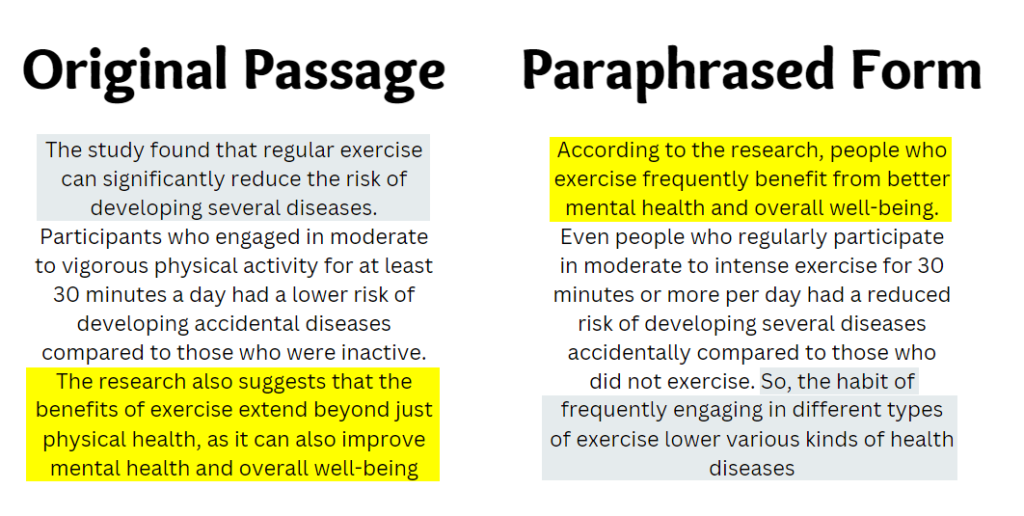
An example of paraphrasing a passage by changing its starting point
- Changing sentence structure is another go-to approach when paraphrasing or summarizing something. But there are different ways of implementing this. For instance, you can perform the active-to-passive conversion or use the reverse conditional approach. So, here are two examples of changing the sentence structures through active-to-passive voice conversion and reverse conditional sentences:
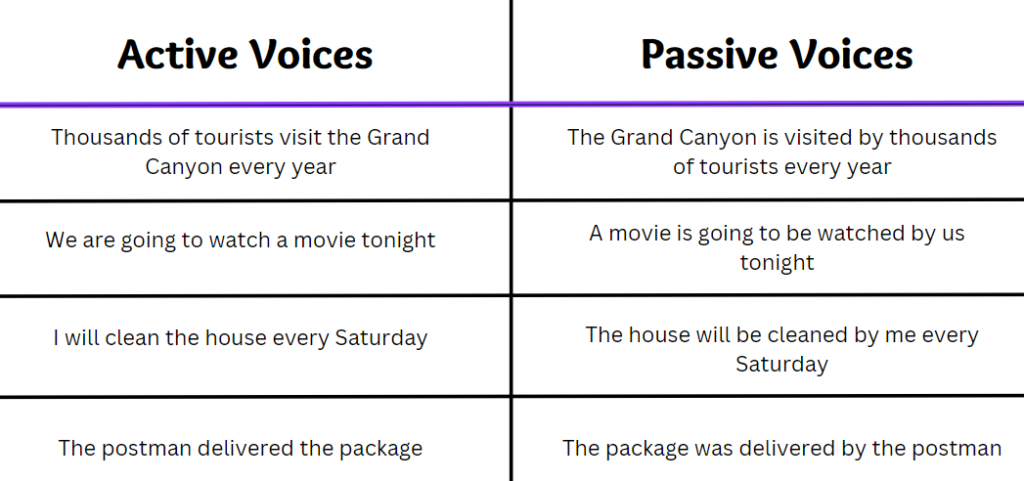
A simple example of different types of active to passive voice conversions
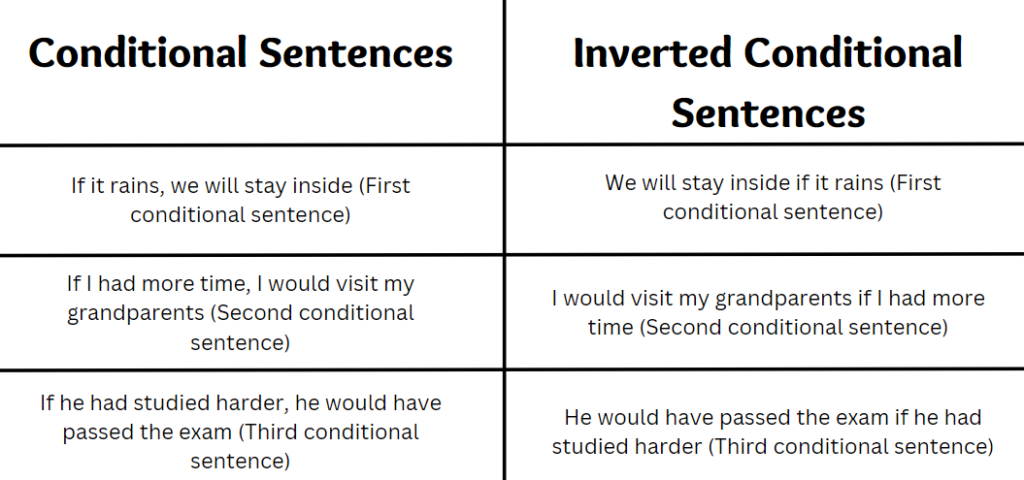
An example of different types of conditional sentences and their reversed forms
- During changing sentence structures, you can also take assistance from a Thesaurus to replace some keywords with their appropriate synonyms or antonyms. But it’s best if you don’t use this tip as a standalone way of writing something in your words. That’s because word replacement alone is not enough to make something unique.
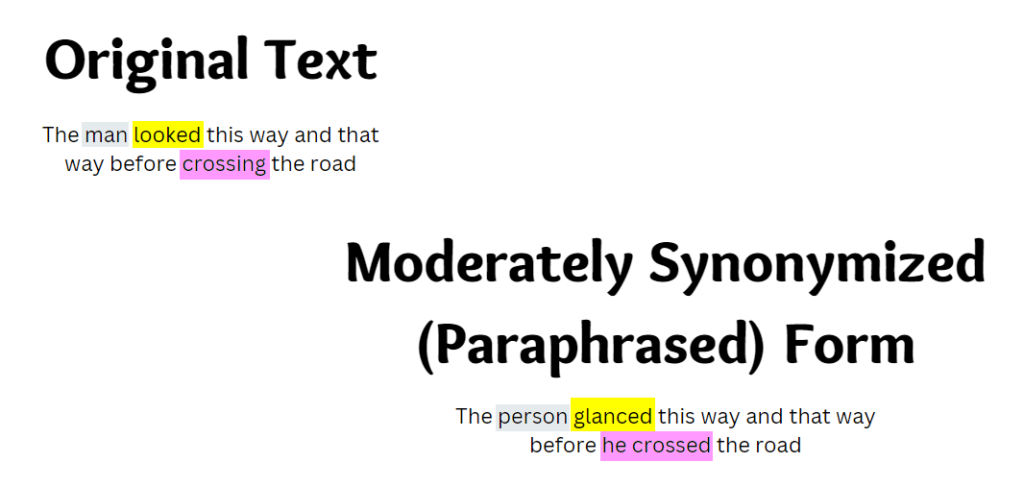
Paraphrasing through synonymizing

Finding synonyms of two words from a thesaurus
But whether you paraphrase the information or summarize it, it is essential to credit the original owner. Otherwise, the paraphrased or summarized information will be considered plagiarism.
- Keep Track of Your Sources
One of the most common instances of plagiarism is source-based, which occurs when a candidate forgets to cite a source. So, to prevent such instances, we recommend keeping track of your sources, which is the third plagiarism prevention strategy.
Source-based plagiarism mainly occurs while working on a lengthy topic because such topics often have an extensive research phase. So, when candidates misplace a source during research and include information from that source, this leads to source-based plagiarism. But you can avoid this by jotting down the references in a separate list. Let’s elaborate on this more.
Whenever you take data or inspiration from a source, you can add that source to a list. This way, you will never miss a reference. And once you’ve completed the draft, you can add all the sources from the list to the reference or bibliography page.
Here is an example of how a perfectly crafted bibliography and reference page will look like (Birmingham):


- Use Quotation Marks and Add Citations Where Necessary
As we’ve already discussed, everybody takes inspiration from somewhere while creating something. But sometimes, taking inspiration is not enough. You have to include the exact information from a source. And that’s where quotation marks will come in handy, which is the last plagiarism prevention strategy in this how to avoid plagiarism guide.
Quotation marks (“”) inform the readers that the information enclosed in double quotes is taken from a particular source. And to mention that specific source, you will need in-text citations, which will be further referenced in a bibliography or a reference page. So, let’s see the practical implementation of this plagiarism prevention strategy through the following example:


The first image demonstrates that the concepts of ‘paraphrasing’ and ‘summarizing’ are taken from ‘Dictionary.com’ and ‘Merriam-Webster.’ On the other hand, the second image shows the complete reference of those definitions in the APA referencing style. So, that’s how you can use this concept to prevent plagiarism.
Disclaimer: It is essential to follow the citation style mentioned in the document’s guidelines and use that style throughout the document. But suppose your assignment doesn’t specify using a particular citation style in its requirements. In that case, we recommend asking your instructor or reading your institute’s citation guidelines because it’s better to be safe than sorry.
Some Resources to Help in Plagiarism Prevention
Undoubtedly, the strategies we have discussed in this guide will prove helpful in keeping plagiarism away. But if you want to make plagiarism prevention more effortless for you, you can resort to these two resources:
- Plagiarism Checker Software
Using a plagiarism checker is still one of the most overlooked techniques for avoiding plagiarism. That’s because most students think that after implementing the plagiarism prevention strategies, they can straightaway submit the document. But that’s where they are wrong.
Even after implementing different plagiarism prevention techniques, the chances of accidental plagiarism remain. Therefore, we recommend using plagiarism detection software and performing a last check on your document. But which plagiarism checker is suitable for students?
We have read several reviews regarding picking a plagiarism checker for students. And after reading those reviews and personal testing, we have found the plagiarism detectors of Grammarly and Check-Plagiarism to be quite effective. So, let’s prove the accuracy of these tools through an example.
Here, we’ll use an instance of a sample text from the internet, as we want to demonstrate the accuracy of recommended plagiarism checkers.
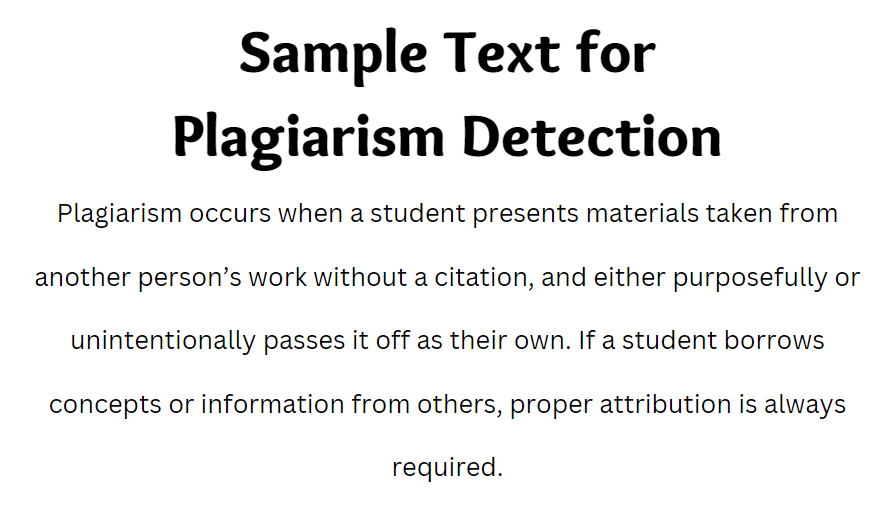
After running the above sample in both recommended plagiarism detectors, here are the results we’ve got in our case:

Source: (https://www.check-plagiarism.com/)

Source: (https://www.grammarly.com/plagiarism-checker)
As the above images indicate, both tools have detected that the text is completely plagiarized. So, that’s how you can identify the originality status of your work before finalizing it. And if a plagiarism detector has detected copied text in your content, you can use the above-discussed techniques to make your work plagiarism-free.
- Citation Generator Tool
As we’ve already discussed, properly citing references is essential to plagiarism-free work. But when so many citation styles are available, it can be difficult to remember the pattern of each style. Therefore, we recommend using a one-click citation generator tool in such a situation.
Like the tools to detect plagiarism, the internet has a plethora of options for citation generators. But according to our experience, the citation generators of QuillBot and Editpad.org are the most easy-to-use tools. So, here is how both selected citation generators have presented the results in our case:

The output of QuillBot’s citation generator

The output of Editpad.org’s citation generator
As you can see, both tools have cited the reference according to the up-to-date styles. So, that’s how you can pick any accurate and up-to-date citation generator for creating citations with one click.
Conclusion
All in all, plagiarism is a severe academic offense because it can even get students expelled from institutes. So, even though the internet has made it easier to plagiarize information, you should try your best to avoid it. And to help you on your way to avoiding plagiarism, we have prepared this guide.
This guide outlines the four most effective plagiarism prevention strategies: conducting proper research, paraphrasing and summarizing, keeping track of sources and citing sources. So, follow them to get success in creating plagiarism-free assignments. However, if you don’t know how to cite the sources correctly, you can take assistance from the above-mentioned resources to prevent plagiarism.


